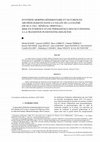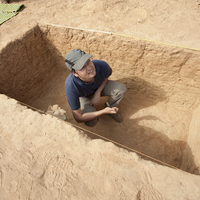Geoarchaeology and Paleoenvironment in West Africa by Sarah Davidoux

Quaternaire, 2020
Les études menées le long de la Falémé, affluent du Sénégal, dans le secteur Sansandé-Missira, pe... more Les études menées le long de la Falémé, affluent du Sénégal, dans le secteur Sansandé-Missira, permettent de se faire une idée assez précise de la stratigraphie des formations sédimentaires qui se dévoilent à la faveur de l'incision récente du cours d'eau. Les datations par le radiocarbone et par luminescence optiquement stimulée calent l'essentiel de ces dépôts du dernier cycle climatique, avec une très bonne représentation de la période 45-5 ka pour les sédiments fins déposés lors des crues régulières. Dans ces dépôts, la récurrence des sites archéologiques montre qu'il y avait, même pendant la phase du dernier maximum aride, un écoulement sud-nord suffisant pour attirer les populations.
ABSTRACT MORPHO-SEDIMENTARY SYNTHESIS AND ARCHAEOLOGICAL OCCURRENCES IN THE FALÉMÉ VALLEY (80-5 KA; EAST SENEGAL): CONTINUING OCCUPATIONS DURING THE PLEISTOCENE-HOLOCENE TRANSITION Studies conducted along the Falémé River (East Senegal) since 2011, in Sansande-Missira sector, inform our understanding of the stratigraphy of Pleistocene alluvial formations. Radiocarbon and optically stimulated luminescence dating set a robust chronostratigraphical framework, of the last climate cycle and especially of the 45-5 ka period. The fine formations, punctuated by coarse formations, document the permanence of the flows while the recurrence of archaeological sites shows that there was sufficient flow to attract Palaeolithic populations, even during the last dry period.







Uploads
Geoarchaeology and Paleoenvironment in West Africa by Sarah Davidoux
ABSTRACT MORPHO-SEDIMENTARY SYNTHESIS AND ARCHAEOLOGICAL OCCURRENCES IN THE FALÉMÉ VALLEY (80-5 KA; EAST SENEGAL): CONTINUING OCCUPATIONS DURING THE PLEISTOCENE-HOLOCENE TRANSITION Studies conducted along the Falémé River (East Senegal) since 2011, in Sansande-Missira sector, inform our understanding of the stratigraphy of Pleistocene alluvial formations. Radiocarbon and optically stimulated luminescence dating set a robust chronostratigraphical framework, of the last climate cycle and especially of the 45-5 ka period. The fine formations, punctuated by coarse formations, document the permanence of the flows while the recurrence of archaeological sites shows that there was sufficient flow to attract Palaeolithic populations, even during the last dry period.
ABSTRACT MORPHO-SEDIMENTARY SYNTHESIS AND ARCHAEOLOGICAL OCCURRENCES IN THE FALÉMÉ VALLEY (80-5 KA; EAST SENEGAL): CONTINUING OCCUPATIONS DURING THE PLEISTOCENE-HOLOCENE TRANSITION Studies conducted along the Falémé River (East Senegal) since 2011, in Sansande-Missira sector, inform our understanding of the stratigraphy of Pleistocene alluvial formations. Radiocarbon and optically stimulated luminescence dating set a robust chronostratigraphical framework, of the last climate cycle and especially of the 45-5 ka period. The fine formations, punctuated by coarse formations, document the permanence of the flows while the recurrence of archaeological sites shows that there was sufficient flow to attract Palaeolithic populations, even during the last dry period.